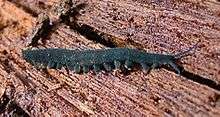Peripatopsidae
| Peripatopsidae | |
|---|---|
 | |
| Euperipatoides kanangrensis | |
| Scientific classification | |
| Kingdom: | Animalia |
| Phylum: | Onychophora |
| Class: | Udeonychophora |
| Order: | Euonychophora |
| Family: | Peripatopsidae Bouvier, 1907 |
| Genera | |
|
See text | |
 | |
| Global range of Onychophora: Peripatidae in green, Peripatopsidae in red | |
Peripatopsidae is one of the two living velvet worm families.[1][2]
Description
The Peripatopsidae exhibit relatively many characteristics that are perceived as original or "primitive" with respect to the Peripatidae. They have between 13 and 25 pairs of legs, behind or between the last of which is the genital opening (gonopore). Both oviparous and ovoviviparous, as well as genuinely viviparous, species exist, although the Peripatopsidae essentially lack a placenta.
Distribution
The distribution of the Peripatopsidae is circumaustral; in particular, they inhabit Australasia, South Africa and Chile.[3]
Genera
The family contains the following genera:[4]
- Acanthokara
- Aethrikos
- Aktinothele
- Anoplokaros
- Austroperipatus
- Baeothele
- Centrorumis
- Cephalofovea
- Critolaus
- Dactylothele
- Dystactotylos
- Euperipatoides
- Florelliceps
- Hylonomoipos
- Konothele
- Kumbadjena
- Lathropatus
- Leuropezos
- Mantonipatus
- Metaperipatus
- Minyplanetes
- Nodocapitus
- Occiperipatoides
- Ooperipatellus
- Ooperipatus
- Opisthopatus
- Paraperipatus
- Paropisthopatus
- Peripatoides
- Peripatopsis
- Phallocephale
- Planipapillus
- Regimitra
- Ruhbergia
- Sphenoparme
- Tasmanipatus
- Tetrameraden
- Vescerro
- Wambalana
References
| Wikispecies has information related to: Peripatopsidae |
| External identifiers for Peripatopsidae | |
|---|---|
| Encyclopedia of Life | 6931 |
- ↑ Oliveira I., Hering L., & Mayer, G. "Updated Onychophora checklist". Onychophora Website. Retrieved 24 November 2016.
- ↑ "Peripatopsidae (Bouvier, 1907)". Integrated Taxonomic Information System. Retrieved 17 March 2014.
- ↑ Oliveira, I. S.; Read, V. M. S. J.; Mayer, G. (2012). "A world checklist of Onychophora (velvet worms), with notes on nomenclature and status of names". Zookeys (211): 1-70. doi:10.3897/zookeys.211.3463.
- ↑ "Australian Faunal Directory". Australian Government Department of the Environment. Retrieved 29 June 2016.
This article is issued from Wikipedia - version of the 11/28/2016. The text is available under the Creative Commons Attribution/Share Alike but additional terms may apply for the media files.